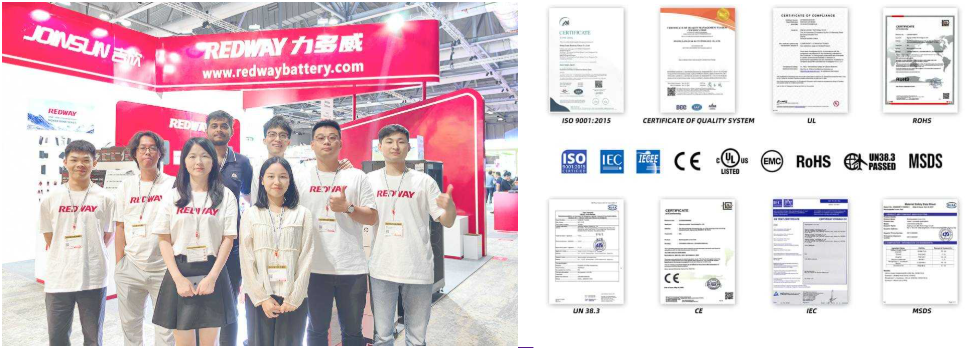2025 The best forklift batteries include lead-acid, lithium-ion, and nickel-based options. Lithium-ion batteries offer fast charging and longer lifespans, while lead-acid remains cost-effective. To optimize lifespan, avoid deep discharges, maintain proper water levels (for lead-acid), and store batteries in temperature-controlled environments. Regular maintenance can extend battery life by 20–30%.
48V 300Ah Lithium Forklift Battery
What Types of Batteries Are Used in Forklifts?
Forklifts primarily use three battery types: flooded lead-acid (FLA), lithium-ion, and nickel-iron. Lead-acid batteries dominate 75% of the market due to lower upfront costs. Lithium-ion batteries, though 2-3x pricier upfront, last 2-3x longer and charge 50% faster. Nickel-iron batteries are rare but excel in extreme temperatures, making them ideal for specialized industrial applications.
How Do You Choose the Right Battery Capacity for Your Forklift?
Calculate required capacity using the formula: (Operating Hours × Average Amp Draw) ÷ 0.8 (to avoid full discharge). For example, a 500-amp motor running 8 hours needs a 5,000 Ah battery. Always cross-check with the forklift manufacturer’s voltage specifications—48V systems are standard for heavy-duty models, while 24V suits smaller electric forklifts.
Consider duty cycles and peak demands when sizing batteries. A warehouse operating three shifts daily requires 20% more capacity than single-shift operations to account for shorter charging windows. Use this table as a guideline:
| Forklift Class | Typical Voltage | Capacity Range |
|---|---|---|
| Class I Electric | 24V-48V | 400-1,200 Ah |
| Class II Electric | 48V-80V | 800-2,000 Ah |
| Class III Electric | 12V-36V | 200-600 Ah |
What Maintenance Practices Extend Forklift Battery Life?
Key practices include:
- Watering lead-acid batteries weekly (distilled water only)
- Cleaning terminals monthly with baking soda solutions
- Equalizing charges every 10-15 cycles
- Storing at 40-80% charge in 59–77°F environments
Neglecting these can reduce lifespan by 40%, according to Industrial Battery Engineering.
Implement a maintenance log to track hydration levels and terminal corrosion. Lithium-ion batteries require different care – monitor cell balancing and keep firmware updated. Thermal imaging inspections every quarter can detect hot spots before failures occur. Consider these comparative maintenance schedules:
| Task | Lead-Acid Frequency | Lithium-Ion Frequency |
|---|---|---|
| Voltage Checks | Daily | Weekly |
| Deep Cleaning | Monthly | Quarterly |
| Full Diagnostics | Bi-Annually | Annually |
How Does Charging Frequency Impact Battery Performance?
Partial charging (20-80% range) boosts lithium-ion cycles to 3,000+ vs. 1,200 full cycles. For lead-acid, shallow discharges (<30%) extend life to 1,500 cycles vs. 500 deep cycles. Overcharging increases lead-acid water loss by 25% and accelerates plate corrosion. Smart chargers with temperature compensation optimize charging by adjusting voltage based on ambient heat.
What Are the Hidden Costs of Improper Battery Disposal?
Improper disposal of lead-acid batteries risks $10,000+ EPA fines per incident. Recycling recovers 99% of lead but costs $50–$150/ton. Lithium-ion disposal requires certified handlers—incinerating them releases toxic HF gas. Many states mandate 95%+ recycling rates, with non-compliance penalties up to 5% of annual revenue for large fleets.
How Do Temperature Extremes Affect Forklift Batteries?
Below 32°F, lead-acid batteries lose 30-40% capacity; lithium-ion loses 15-20%. Above 104°F, lead-acid water evaporation triples, while lithium-ion risks thermal runaway at 158°F. Insulated battery compartments and phase-change materials can stabilize temperatures, improving winter performance by 25% and reducing summer degradation by 18% (per Oak Ridge National Lab studies).
Expert Views
Modern lithium forklift batteries now achieve 98% energy efficiency versus 80% for lead-acid,” says Redway Power‘s Chief Engineer. “Our latest models integrate IoT sensors that predict failures 6 weeks in advance by analyzing voltage dip patterns. Fleets using predictive analytics report 55% fewer unplanned downtimes.”
Conclusion
Optimizing forklift batteries requires balancing chemistry choices, load management, and proactive maintenance. With lithium-ion ROI reaching break-even at 1,700 cycles and smart monitoring cutting waste by 30%, evolving battery tech is reshaping material handling logistics. Regular staff training and adopting telematics can amplify these benefits across operations.
FAQs
- Can I retrofit lithium batteries into older forklifts?
- Yes, but requires voltage compatibility checks and BMS integration. Expect $2,000–$5,000 retrofit costs per unit.
- How often should battery fluid levels be checked?
- Lead-acid batteries need weekly checks in high-use (3-shift) operations, monthly in single-shift scenarios.
- Are solar-powered forklift chargers viable?
- Yes—500W solar arrays can offset 30% of charging costs, with payback periods under 4 years in sunny regions.





